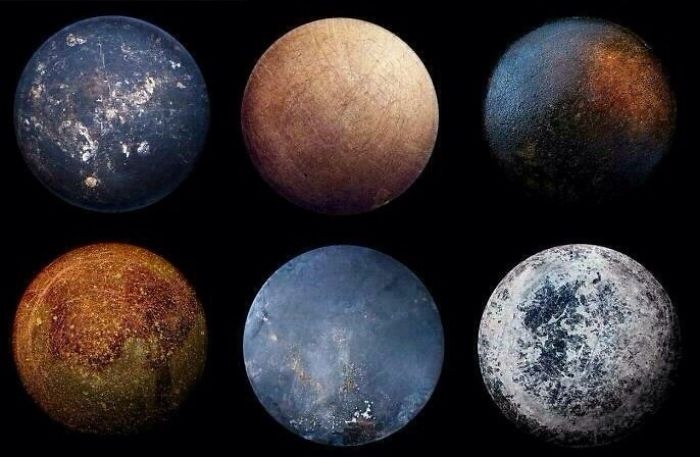Laying on the hood of my dad’s ‘82 Oldsmobile, staring at the stars, I used to dream of how to explore the sky. What could I do to get to space? (I was also obsessed with Space Camp, thank you, Lea Thompson).
I’ve been creating options of exploring and excitement for a long time. It’s part of my personality.
Personality is part of your character that developed so you could make sense of the outside world. Personality is how we filtered the crazy confusing world around us. It’s how we protected ourselves and got our needs met. Personality is who we believe ourselves to be.
But personality is actually ego, a mechanical way of seeing the world that limits our growth and covers our essence.
That picture up there isn’t planets. My story about stargazing (which is true by the way! I still love the stars) made you see the picture as planets. But the essence of that picture is the bottom of old frying pans.
The story determines how we see.
The Enneagram helps us discover how we see. It shows us what stories we believe about ourselves in every area of our lives. And we interpret everything through the lens of that story. Other personality systems show us how we predictably think, feel, and act, which has a lot of value. But the Enneagram show us why. It shows us how we see.
This is why personality matters so much in leadership. Most people are caught up in the story of their personality and respond mechanically to that story. Everything is seen through that story.
And those stories are all different. Those mechanical responses cause conflict and angst, increase disengagement and burnout, and decrease belonging and productivity.
If everyone is filtering through their own lens, then how do solve for personality?
Suzanne Stabile says. “You can’t change how you see—you can only change what you do with how you see.”
The first step is identifying how you see. The Enneagram shows us nine different ways to see.
Story-lens of each type:
1: If it’s not perfect, I am bad.
2: If I don’t help, I don’t have value.
3: If I don’t succeed, I don’t have significance.
4: If I’m not special, I don’t have identity.
5: If I don’t know, I am unsafe.
6: If I’m not prepared, I’ll be abandoned.
7: If I’m limited, I’ll experience pain.
8: If I’m not protecting, I will be controlled.
9: If there is conflict, I will lose connection.
So let’s consider this for a moment. If your story-lens is I want to avoid limits so you create all the options and you are on a project with someone whose story lens is to be perfectly good so they look for the one right way…can you see the conflict coming?
If you live unaware of the story you see through, you will forever see pans as the stars and act accordingly.
The work of the enneagram, at its simplistic application, is to recognize your story lens, and choose an action that is intentional (preferably healthy!), rather than mechanical.
The Enneagram doesn’t put you in a box. It shows you the box that’s keeping you limited you’re in and the way out to a fuller, whole life.
Here’s your action step:
This week, notice when one of these stories comes up for you. And what would happen if you choose a new story.
Try moving to this story:
1: I am already good.
2: I am loved and valued.
3: I am significant because I am a human being.
4: I don’t have to prove that I am special.
5: I can not know and be comfortable.
6: I am safe and secure.
7: I can move through pain.
8: I can be vulnerable and strong.
9: My presence matters.
Your leadership (and your life) will feel a little more whole.
——
Interested in a bit more about how to use the Enneagram to improve your leadership? The Catalyst Leadership Lab is opening soon. Join the waitlist now, and you’ll get first dibs on the limited spots. Join the waitlist here.

Understanding others is loving others ❤️ Thank you for sharing!